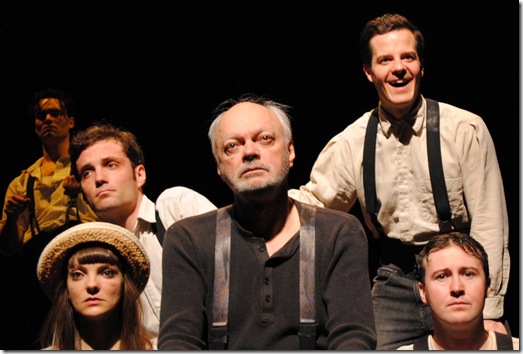Take Me Back To Jefferson: More Show-Off Than Substance
Dean Gilmour as Anse, the patriarch of the family
The youth is engaged in a battle of wills with the unruly horse that he loves. And he seems to be straining every muscle as he’s thrown about the stage and into the air by the whiplash resistance of his steed. But, of course, there’s no animal on the stage of the NAC Theatre — except in our imagination.
However, we do have a determined young actor named Ben Muir in the role of Jewel, the fierce and haunted bastard son who is perhaps the most compelling character in Take Me Back To Jefferson — the title lately bestowed by Theatre Smith-Gilmour on its 2013 adaptation of William Faulkner’s great novel, As I Lay Dying.
There’s no denying the impact of Muir’s scenes with the invisible horse — and that includes the moments when he also takes on the animal’s identity and its bucking, rearing body language. Further enlivened by assorted snorts, neighs and gasps, this adds up to an impressive demonstration of the mime technique. But it becomes too much of a demonstration — lasting longer than necessary. And although aspects of it do communicate Jewel’s inner torment, there’s also a subliminal message being delivered here.
Indeed, it’s a message that often permeates this visiting Toronto production. Look at us — aren’t we clever?
Take Me Back To Jefferson arrives in Ottawa on a wave of generally ecstatic reviews from Toronto critics. And there’s no denying that, on one level, it yields some fascinating moments and shows the dividends that can be derived from collaborative theatre. Furthermore, this Toronto company — known for its success with literary adaptations — showed a lot of courage in trying to navigate the nightmare landscape of Faulkner’s 1930 stream-of-consciousness classic.
Adaptors Michele Smith and Dean Gilmour, who also direct and act in this piece, have sought to recreate the elusive texture of Faulkner’s tattered saga of the dirt-poor Bundren family and the mythic 40-mile journey it undertakes in order to satisfy the wishes of their deceased matriarch, Addie, that she be buried in her home town of Jefferson. And they and their gifted cast, most of whom assume more than one role, do deliver some powerful set-piece moments — a disastrous attempt to ford a river during flood season, a terrifying barn fire, Jewel’s struggles with the horse.
But do such scenes really bring further illumination to Faulkner’s intentions? Or do they merely supply the Toronto group with the opportunity to show off — to put on a display of how much illusion it can create on a bare stage with a minimum of props? And do we ever cease to be aware that this is no more than illusion presented in a highly stylized form? Indeed, that illusion can sometimes by rendered vulnerable here by the wrong kind of reality. When, in the midst of watery chaos, it’s the deceased Addie’s turn to rise from her putrefying state and deliver one of the play’s interior monologues, Michelle Smith’s cultivated and heavily accented contribution has us asking questions we shouldn’t be asking. Such as — is this supposed to be rural Mississippi?
There should surely be some greater merit in aspiring to transfer Faulkner’s surrealistic tour-de-force to the stage beyond the desire simply to prove that it can be done. And for all the harsh visual imagery and the responsiveness of the cast, how aware are we really of the lies and family secrets that hang over the Faulkner original like a shroud? How much genuine insight do we get into the inner lives of the characters? It does happen on occasion, but most persuasively in those moments when the production shifts into naturalism — for example, when Nina Gilmour, touching and vulnerable in the role of the pregnant Dewy Dell, visits a pharmacist in search of an end to her crisis. Or the moment when Dan Watson’s Cash endures a horse doctor’s attempt to mend his broken leg. Or in the skill Julian de Zotti demonstrates in delineating Darl’s descent into madness. Or in the way Ben Muir conveys Jewel’s unhappy, driven spirit.
Yet this same Ben Muir lapses into over the-top-caricature when he turns Doc Peabody (a recurring character in Faulkner’s fiction) into a blustering, wheezing buffoon. And Dean Gilmour is surprisingly one note in his portrayal of Anse, the clan’s infernal patriarch figure whose involvement in its bizarre journey is fuelled by a desire for a new set of dentures. Despite the stalwart efforts of the cast, augmented by Andre Du Toit’s atmospheric lighting and a cunning soundscape, the production lacks a consistent voice.
Those bold and imaginative visuals do linger in the mind — but not enough to allow one to forget what Chicago’s Steppenwolf company did with another Depression classic, John Steinbeck’s The Grapes Of Wrath. But of course Steppenwolf was clearly seeking to serve the material — and did so brilliantly. Can the same be said of Take Me Back To Jefferson?
Take Me Back to Jefferson
Adapted by Michele Smith and Dean Gilmour
Based on As I Lay Dying by William Faulkner
A Theatre Smith-Gilmour Production (Toronto) at the NAC Theatre
Co-directors: Michele Smith and Dean Gilmour
Set and costumes: Teresa Przybylski
Lighting: André Du Toit
Cast:
Darl, Samson……………………………………….Julian de Zotti
Anse, Moseley, Rev. Whitfield, Quick…………….Dean Gilmour
Dewy Dell, Little John, Lula……………………….Nina Gilmour
Jewel, Peabody, the Marshall………………………Ben Muir
Vardaman, Armstid…………………………………Daniel Roberts
Addie………………………………………………..Michele Smith
Cash, Tull, Gillespie, MacGowan…………………..Dan Watson
Take Me Back to Jefferson continues at the NAC Theatre to April 11.
